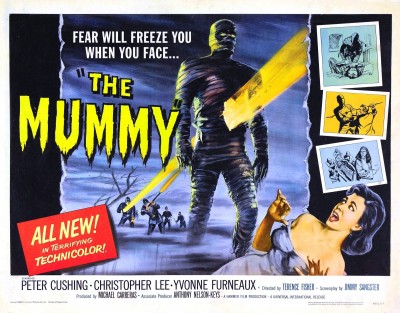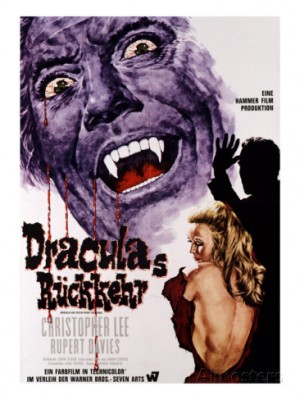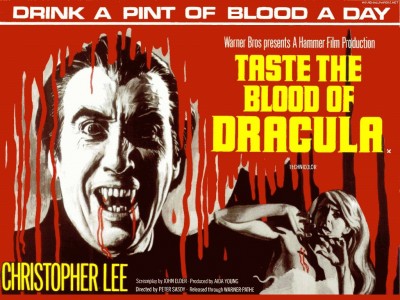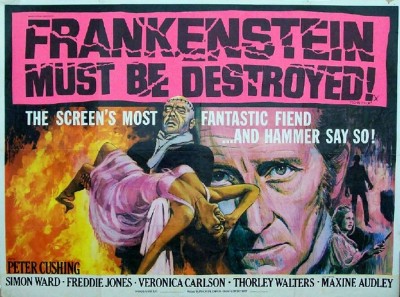| Reviews & Columns |
|
Reviews DVD TV on DVD Blu-ray 4K UHD International DVDs In Theaters Reviews by Studio Video Games Features Collector Series DVDs Easter Egg Database Interviews DVD Talk Radio Feature Articles Columns Anime Talk DVD Savant Horror DVDs The M.O.D. Squad Art House HD Talk Silent DVD
|
DVD Talk Forum |
|
|
| Resources |
|
DVD Price Search Customer Service #'s RCE Info Links |
|
Columns
|
|
|
Horror Classics, Vol. 1 (The Mummy/Dracula Has Risen from the Grave/Taste the Blood of Dracula/Frankenstein Must Be Destroyed)
Of the four, only The Mummy was previously available, as an extras-packed Region B release in the U.K. Warner's release seems to utilize the same sparkling transfer, and while this set is notably bereft of supplements, it's still a handsome, very satisfying package.
Produced in the wake of Hammer's worldwide success with The Curse of Frankenstein and Dracula (aka The Horror of Dracula, 1958), The Mummy was part of a multi-picture deal with Universal-International in which the latter pretty much gave the British company carte blanche access to their classic horror properties of the 1930s and ‘40s. The Mummy is in many ways the most interesting of these as it deftly cherry-picks elements from the classic 1932 original starring Boris Karloff as well as the lesser The Mummy's Hand (1940), The Mummy's Tomb (1942) and The Mummy's Ghost (1944).
Hammer's film, therefore, plays almost like a Greatest Hits semi-remake of all of these pictures, while significantly improving and building upon character and story elements found in Universal's mostly terrible Mummy sequels. The most profound difference is the Mummy himself. Kharis, played in most of the ‘40s sequels by an unenthusiastic, foot-dragging Lon Chaney Jr., the actor saddled with an immobile rubber mask with but a single eye hole, here is breathtakingly transformed by Christopher Lee.
Lee's only advantage was two eyeholes through a similarly immobile mask instead of one, yet almost miraculously the actor expresses every ounce of Kharis's tragic fate, his love for the Princess Ananka, and his despair at being brought back to unhappy life. And where Chaney moved like a zombie doped up on Prozac, Lee's pantomiming transforms Kharis, into a powerful, cunning, and fast-on-his-feet living dead.
It's Lee's picture all the way, but top-billed Peter Cushing is in reliably fine form as archeologist John Banning, who gradually realizes that he along with various colleagues and relatives have been cursed for desecrating the Princess's sacred tomb. And despite a very modest budget of just GBP 125,000, it's a handsome, polished production with, for the time, some real scares. (**** 1/2 out of ****)
Dracula Has Risen from the Grave (1968) was the third Dracula sequel following Dracula (with Cushing and Lee), The Brides of Dracula (with Cushing, 1960), and Dracula - Prince of Darkness (with Lee, 1966) and far more successful at the box office than anyone had anticipated. Less highly regarded than its predecessors, the film in fact improves markedly upon Prince of Darkness, in which its quartet of protagonists are consistently, annoyingly foolish throughout. Dracula Has Risen from the Grave, by contrast, has far more likeable characters, a stronger story, and livelier direction, this time from cinematographer Freddie Francis (replacing Terence Fisher, director of the three earlier films, as well as The Mummy), despite some gaps in logic and a couple of glaring continuity errors.
The plot concerns Dracula's (Lee) revenge against Monsignor Ernest Mueller (Rupert Davies) after the latter exorcises Dracula's castle, placing a large crucifix at its gate, preventing the Count access inside it. Dracula plots to make Mueller's beautiful niece, Maria (Veronica Carlson) his slave. Maria, meanwhile, tries to convince her kind but pious uncle to accept her romantic relationship with atheist boyfriend Paul (Barry Andrews), whose denial of the existence of God poses problems during the film's action-filled, gory climax.
Though far from great, Dracula Has Risen from the Grave has a much sturdier script than its immediate predecessor, decent production values, and was the last "pure" Hammer Dracula film in the sense that all of the remaining sequels (Taste the Blood of Dracula, Scars of Dracula [1970], Dracula A.D. 1972 [1972], The Satanic Rites of Dracula [1973], and The Legend of the 7 Golden Vampires [1974]), while occasionally entertaining and effective, are greatly compromised in one way or another. (****)
To wit: Taste the Blood of Dracula, conceived as a vehicle for actor Ralph Bates and minus Lee, until financier Warner Bros. insisted Lee's Count be part of the package. Shoehorning Dracula into the plot pleased no one, least of all Lee, who in subsequent years endlessly retold the story of how he refused to do it until being informed that his non-involvement would "put a lot of people out of work."
The story revolves around a trio of Edwardian English "gentlemen": William Hargood (Geoffrey Keen), Samuel Paxton (Peter Sallis, the voice of Wallace in the "Wallace and Gromit" series), and Jonathan Secker (John Carson). Outwardly they are pillars of English society but, secretly, they indulge themselves in the pleasures of the flesh, visiting brothels in Whitechapel while telling loved ones they're off doing charity work.
Hargood is singularly sanctimonious at home, particularly toward his daughter, Alice (Linda Hayden), whom he forbids any sort of relationship with upstanding young suitor Paul (Anthony Corlan), Paxton's son.
Bored by their weekly visits to the brothel, the trio seeks out greater sins against the Almighty, soliciting advice from disinherited ne'er do-well and Satanist Lord Courtley (Ralph Bates). He implores the men to purchase the ring, cloak, and especially the Cherry Kool-Aid-like dried blood of Count Dracula from antique dealer Weller (Roy Kinnear, in an amusing performance).
At an abandoned church Courtley and the men begin a ceremony in which Courtley's blood is mixed with Dracula's, but the bubbling effect of the brew puts off the three gentlemen, who suddenly refuse to partake after Courtney downs a goblet-full. Feeling cheated (or something) they beat Courtley to death, but soon after his lifeless body transforms, via bad special effects, into Dracula (Lee) himself, who quite uncharacteristically vows revenge against his loyal servant.
Surprisingly, several genre scholars hold Taste the Blood of Dracula in high regard, mainly for its obvious but effective damnation of upper class hypocrisy. Partly this is understandable as Geoffrey Keen, who spent a lifetime playing similar authority figures, is genuinely and believably abominable toward his long-suffering wife (Gwen Watford) and daughter. And the idea of upstanding citizen Hargood and the others seduced by sin (all the while behaving utterly unfazed, prim and proper) has promise, as does Bates's unrepentant outcast.
But as a Dracula movie, Taste the Blood is notably disappointing, with Lee given next to nothing to do other than count off his victims like Sesame Street's muppet The Count, made even sillier by Lee's resolutely serious line readings: "The f-i-i-i-i-r-r-r-r-s-s-s-t." The picture's climax is particularly dopey. (** 1/2)
By far the best of Hammer's Frankenstein films, Frankenstein Must Be Destroyed followed The Curse of Frankenstein (good but overly cautious and too staid for its own good), The Revenge of Frankenstein (clever but deviates a bit too far from genre iconography, 1958), The Evil of Frankenstein (the most lavish but the script is weak, 1964), Frankenstein Created Woman (depressing terrible-things-happen-to-innocent-people script, 1967) and precedes Frankenstein and the Monster from Hell (not bad but low budget hurts it, 1972).
As writer Bill Warren rightly observes, throughout the course of the series star Peter Cushing altered his characterization to meet the needs of each script. In some of the films he's quite malevolent, while in others he's more or less benign. Yet, throughout, there's no question that Cushing is playing the same character in all of the films, and always is never less than excellent. In Frankenstein Must Be Destroyed he's even better than that, this time playing a brilliant but sociopathic scientist who by this point has lost all traces of his humanity, a quality superseded completely by an ends-justify-the-means determination.
This entry has renegade Baron Frankenstein taking over Anna Spengler's (Veronica Carlson again) boarding house, blackmailing her and her fiancé Karl Holst (Simon Ward), a young doctor at a nearby asylum. There, a colleague of Frankenstein's, Dr. Brandt, has been committed for insanity but with information vital to Frankenstein's experiments locked in his subconscious,. Eventually Frankenstein transfers that man's brain into the body of another asylum doctor, Richter (Freddie Jones). Unwillingly revived by Frankenstein, Richter/Brandt becomes a victim of his own brain-swapping theories and plots revenge against Frankenstein, now literally the monster as well as the scientist.
Everything about the film plays marvelously well (though some of the narrative seems missing; Just how did Karl lure Richter to the boarding house anyway?), including a controversial rape scene, added late during the production. The genuinely disturbing sequence, of Frankenstein overpowering Anna, is perhaps the most misunderstood in all of Hammer horror. It is not, as many wrongly assume, a badly-timed impromptu sexual dalliance of the Baron's part, but rather a brutal act of domination, Frankenstein's violent way of demonstrating just who's in charge, as many rapes are. Indeed, despite its genre trappings this sequence is one of the more creepily authentic acts of sexual violence depicted in the movies, certainly in movies up to that time.
From James Bernard's superb score (and notice how in this and the two Draculas Bernard's main themes always match the title syllable-for-syllable) to its slam-bang opening (featuring, perhaps, Cushing greatest onscreen entrance) to innumerable scenes with Cushing (the best of which involves a lengthy sequence with Brandt's wife, played by Maxine Audley, ending with Cushing's unforgettable line), Frankenstein Must Be Destroyed is a genre masterpiece, and Hammer's last great horror movie. (*****)
Video & Audio
All four movies were shot for 1.66:1 widescreen and are either presented in that ratio or 1.78:1, compromising little to nothing. All benefit greatly seen in high-def; even the cheaper late-1960s title have an air of dignity lacking in earlier VHS and DVD presentations, and the original colors have not been tampered with, unlike many other Hammer Blu-ray titles thus far. The Mummy, with original theatrical prints by Technicolor, looks particular rich. Taste the Blood of Dracula is the original 95-minute uncut version, and not the watered-down American theatrical release. The DTS-HD Master Audio (French and Spanish mono is also offered) is generally excellent, though Must Be Destroyed sounds a bit tinny to my ears. Optional English, French, Spanish, and Japanese subtitles are offered. The four discs are region-free, and are accompanied by a colorful but essay-starved booklet.
Extra Features
The lone extras are trailers for all four movies.
Parting Thoughts
Though we Hammer fans would have loved to have seen this two or three Halloweens back, Horror Classics, Volume One is a must. How long will Warner Home Video make us wait for Volume Two, I wonder? A DVD Talk Collectors Series title.
Stuart Galbraith IV is the Kyoto-based film historian and publisher-editor of World Cinema Paradise. His new documentary and latest audio commentary, for the British Film Institute's Blu-ray of Rashomon, is now available while his commentary track for Arrow Video's Battles without Honor and Humanity will be released in November.
|
| Popular Reviews |
| Sponsored Links |
|
|
| Sponsored Links |
|
|
| Release List | Reviews | Shop | Newsletter | Forum | DVD Giveaways | Blu-Ray | Advertise |
|
Copyright 2024 DVDTalk.com All Rights Reserved. Legal Info, Privacy Policy, Terms of Use,
Manage Preferences,
Your Privacy Choices | |||||||

















